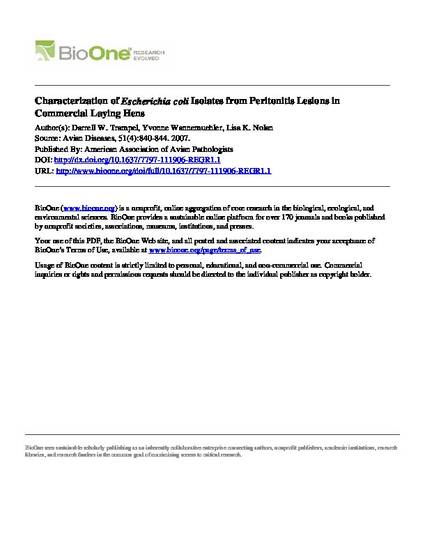
Five clinically normal chickens from three farms (farm A, farm B, and farm C), for a total of 15 clinically normal chickens, were examined bacteriologically. In a similar manner, five dead chickens with lesions of peritonitis from each of the same three commercial egg-laying operations were selected for bacterial culturing. Escherichia coli were isolated from the cloaca in 14 of 15 healthy chickens and from all 15 chickens with peritonitis. Oviducts of normal chickens did not contain E. coli (0/15) whereas oviducts from 13 of 15 hens with peritonitis were positive for this pathogen. No lesions and no E. coli (0/15) were found in the peritoneal cavity of healthy hens, but peritonitis lesions from 13 of 15 dead chickens yielded E. coli. On farm A and farm B, a flock consisted of all chickens within a single house and all chickens in each flock were of the same age and same genetic strain. In flock 1 from farm A, all five E. coli isolates from the oviduct and all five isolates from the peritoneal cavity were serogrouped as O78; contained the virulence genes iroN, sitA, iutA, tsh, and iss; and belonged to phylogenetic group A. In flock 2 from farm B, all four E. coli isolates from the oviduct and all four isolates from the peritoneal cavity were serogrouped as O111; contained virulence genes iroN, sitA, iutA, traT, iss, and ompT; and belonged to phylogenetic group D. These data suggest that all chickens with peritonitis in a single flock on farms A and B were likely infected by the same E. coli strain. Escherichia coli isolates from the magnum and peritoneum had the same serogroup, virulence genotype, and phylogenetic group, which is consistent with an ascending infection from the oviduct to the peritoneal cavity.
Available at: http://works.bepress.com/lisa_nolan/48/

This article is from Avian Diseases 51, no. 4 (2007): 840–844, doi:10.1637/7797-111906-REGR1.1.